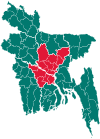Munshiganj Sadar Upazila
This article needs additional citations for verification. (May 2019) |
Munshiganj Sadar
মুন্সীগঞ্জ সদর | |
|---|---|
Upazila | |
 Munshiganj Sadar Location in Bangladesh | |
| Coordinates: 23°27.5′N 90°32.5′E / 23.4583°N 90.5417°ECoordinates: 23°27.5′N 90°32.5′E / 23.4583°N 90.5417°E | |
| Country | |
| Division | Dhaka Division |
| District | Munshiganj District |
| Area | |
| • Total | 160.79 km2 (62.08 sq mi) |
| Population (1991) | |
| • Total | 294,823 |
| • Density | 1,800/km2 (4,700/sq mi) |
| Time zone | UTC+6 (BST) |
| Website | sadar |
Munshiganj Sadar (Bengali: মুন্সীগঞ্জ সদর) is an upazila of Munshiganj District[1] in the Division of Dhaka, Bangladesh.
History[]
In 1971[]
When the Pakistan Army began mass-killing and massacre in Dhaka city on the night of 25 March the students and youths of Munshiganj raided the armoury and captured arms and ammunitions to resist the Pakistan Army on 29 March.[2] They successfully guarded the river-side area to check the onrush of the Pakistan army towards Munshiganj[verification needed]. The people of Narayanganj in alliance with the youths of Munshiganj resisted an attack of the Pakistan Army on 31 March[verification needed]. The Pak army first penetrated into Munshiganj on 9 May and killed some youths at Kewar on 14 May.[2]
Demographics[]
As of the 1991 Bangladesh census, Munshiganj district, formerly a subdivision under Dhaka district, was established in 1984. It consists of 6 upazilas, 67 union parishads, 662 mouzas, 906 villages, 18 wards, 73 mahallas and 2 municipalities.[3]
Administration[]
Munshiganj Sadar Upazila is divided into Mirkadim Municipality, Munshiganj Municipality, and nine union parishads: Adhara, Bajrajogini, Banglabazar, Charkewar, Mohakali, Mollakandi, Panchashar, Rampal, and Shiloy. The union parishads are subdivided into 94 mauzas and 196 villages.[4]
Mirkadim Municipality and Munshiganj Municipality are each subdivided into 9 wards.[4]
Education[]
There are six colleges in the upazila: , , , , , and .[5]
According to Banglapedia, A. V. G. M. Government Girls' High School, founded in 1892, Bajrajogini J. K. High School (1883), Basirannesa High School (1972), Rikaby Bazar GIRLS' High School, Binodpur Ramkumar High School (1919), Edrakpur High School (1970), K. K. Government Institution (1942), Munshiganj M. L. High School (1885), and Rampal N. B. M. High School (1933) are notable secondary schools.[1]
Notable residents[]
- A M Nurul Islam, civil servant, attended Munshiganj High School.[6]
See also[]
- Upazilas of Bangladesh
- Districts of Bangladesh
- Divisions of Bangladesh
References[]
- ^ a b Ratantanu Ghosh (2012), "Munshiganj Sadar Upazila", in Sirajul Islam and Ahmed A. Jamal (ed.), Banglapedia: National Encyclopedia of Bangladesh (Second ed.), Asiatic Society of Bangladesh
- ^ a b Ratantanu Ghosh (2012). "Munshiganj District". In Sirajul Islam; Ahmed A. Jamal (eds.). Banglapedia: National Encyclopedia of Bangladesh (Second ed.). Asiatic Society of Bangladesh.
- ^ "Population Census Wing, BBS". Archived from the original on 2005-03-27. Retrieved November 10, 2006.
- ^ a b "District Statistics 2011: Munshiganj" (PDF). Bangladesh Bureau of Statistics. Retrieved 14 July 2014.
{{cite web}}: CS1 maint: url-status (link) - ^ "List of Colleges". Department of Secondary and Higher Education. Retrieved 6 September 2020.
- ^ Imam, Shah Husain (20 October 2017). "Nurul Islam Anu as I knew him". The Daily Star.
- Upazilas of Munshiganj District

